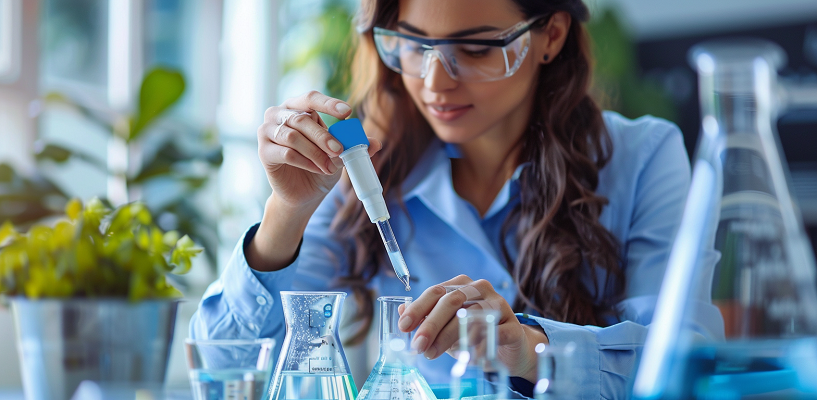ppm

Parts of one material which is found in a “million parts” of another (like water) i.e., no. of molecules of one material which is found in a “million molecules” of another.
‘Parts per million’ is calculated using a substance’s “weight” in relation to another that it is mixed with or connected with. The “ppm” of any given substance is therefore one part (by weight) to one million parts (by weight) of another substance.
A “ppm of a year” is equivalent to around 30 seconds. One year has “365×24×60×60=31,536,000” seconds. And, “31,566,000 ÷ 1,000,000 = 31.53” seconds.
“Part per hundred” is the literal meaning of the word “percent.” So, 1% = 10,000 ppm = 10,000,000 ppb. Further, “ppb” denotes “parts per billion.”
Alternative perspectives on “parts per million” include:
- In a mid-sized automobile tank, one drop of contamination/additive.
- Drop of ink in a sizable kitchen sink (about thirteen gallons).
- One minute in two years.
- One inch in 16 miles.
- One ounce in 32 tons.
- One fluid ounce in 7,812.5 gallons of water.
- One penny in $10,000.
- One car in bumper-to-bumper traffic from Cleveland to San Francisco.
Similarly, “ppma” denotes parts per million atoms i.e., 1 ppma is a fraction of 1 in 106 atoms. Helpful in disciplines where accurate “atomic ratios” are crucial, such as chemistry and materials science industries.
Alternative perspectives on “parts per billion” include:
- Drop of ink in a sizable tanker truck (about 13,000 gallons).
- One vehicle in a “chain of vehicles” that circles the planet 100 times.
- One penny in $10,000,000.
- In a sandbox, one single particle of sand.
- Three seconds out of a century.
- One inch in 16,000 miles.
- One second in 32 years.
- A single sheet within a toilet “paper roll” that stretches from New York to London.
- Ten tons of potato chips with one “pinch of salt” in them.
Measurements of “ppm” and “ppb” are commonly used to describe exposure levels and guidelines designed to shield the public from “dangerous compounds” that can have major negative impacts on health.
Concentrations in Water -
Concentrations of chemicals in water are commonly measured in units of the ‘mass of chemical’ (“milligrams, mg” or “micrograms, µg”) per ‘volume of water’ (liter, L, l).
“Parts per million” (ppm) and “parts per billion” (ppb) are other ways to express concentrations in water. It is possible to switch between “parts per million” and “parts per billion” i.e., 1 ppm = 1000 ppb.
Imagine one drop of chemical/solution in a million droplets of water, or roughly one cup of solution in a swimming pool, to help you understand one “part per million” (ppm) in water. And, one drop of solution in a swimming pool is equivalent to one “part per billion” (ppb).
Considering that the “density of the solution” is equal to the density of water, which is approximately 1 gram per milliliter (1g/mL), or that 1 gram equals the 1 milliliter. Thus,
1 drop in 1,000,000 drop = 0.05 ml in (1,000,000 x 0.05) ml = 1 L in (1,000,000) L
1 L in (1,000,000) L = 10-6 L in 1 L = (10-3 x 10-3) L in 1 L = 1 mg in 1 L
When it comes to water, “1 ppm” is roughly equal to 1 mg/L (sometimes written as mg/l) of contamination, and “1 ppb” is equal to 1 µg/L (sometimes written as µg/l).
Sometimes chemical concentrations in water are expressed in “grams per cubic meter,” or g/m3. As, 1 g/m3 = 1 mg/L = 1 ppm. Likewise, 1 mg/m3 = 1 µg/L = 1 ppb.
Concentrations in Soil -
Concentrations of chemicals in soil are commonly measured in units of the ‘mass of chemical’ (“milligrams, mg” or “micrograms, µg”) per ‘mass of soil’ (kilogram, kg). Since 106 milligrams = 1 kg, in soil, a contaminant’s “1 ppm equals 1 mg/kg” and its 1 ppb equals 1 µg/kg.
Concentrations in Air -
Concentrations of chemicals in air are commonly measured in units of the ‘mass of chemical’ (“milligrams, mg” or “micrograms, µg”) per ‘volume of air’ (cubic meter, or cubic feet). However, a conversion factor is used here to express concentration in “ppm or ppb.”
Each chemical has a “unique” conversion factor because of varying molecular weight. The computation is also impacted by “pressure and temperature” of air.
The standard assumption for chemical transformations in air is a pressure of “one atmosphere” and a temperature of twenty-five degrees Celsius. The following formula can be used to convert concentration in “milligrams per cubic meter” (mg/m3) to ppm:
Concentration (ppm) = 24.45 x concentration (mg/m3) ÷ molecular weight
Here, “24.45 ÷ molecular weight” is the conversion factor with standard assumption of 1 atmosphere and 25°C. The molecular weight of a substance is expressed in “grams per mole,” or g/mol.
One mole of an ideal gas has a volume of 24.45 liters at “standard ambient temperature and pressure” (SATP). The required “temperature and pressure” for SATP are 25°C (298.15 K) and 1 atm (101.325 kPa), respectively. “1 atm” or “1 atmosphere” is the atmospheric pressure.
Examples -
Q. Determine the percentage concentration of NaCL in a solution, having a volume of 95 mL after 7.8 g of NaCl has been dissolved. (Hint: 1 g/100mL = 1 %).
Ans.
Percentage (%) = [mass of solute (in g)] ÷ [volume of solution (in 100ml)],
Percentage (%) = 7.8 g ÷ [ (95 ÷ 100) x 100ml] = (7.8 g) ÷ (.95 x 100ml),
Percentage = (7.8 / .95) x (g / 100ml) = 8.21 x 1 % = 8.21 %
Q. After dissolving 0.0049 g of NaCl to create a solution with a volume of 800 mL, find the concentration in parts per million. (Hint: 1 mg/L = 1 ppm).
Ans.
Concentration (ppm) = [mass of solute (in mg)] ÷ [volume of solution (in L)],
Concentration (ppm) = (0.0049 x 1000 mg) ÷ (800 ÷ 1000 L) = 4.9 mg ÷ 0.8 L,
Concentration = 6.12 ppm
Q. 10 parts per billion is the "Maximum Acceptable Concentration" (MAC) of lead in drinking water. Does a sample surpass the MAC at a concentration of 56 nM. (Hint: 1 M=1 mol/L).
Ans.
The molar mass of lead is approximately 207.2 g/mol. Here, molar concentration is 56 nanomolar (nM). Thus,
56 nM = 56 x 10−9 M = 56 x 10−9 mol/L
Conversion to g/L,
(56 x 10−9 mol/L) x (207.2 g/mol) = (56 x 10−9 x 207.2) x (mol/L) x (g/mol),
11603.2 x 10−9 g/L = 11.603 x 10−6 g/L = 11.603 µg/L,
11.603 ppb, surpassed the MAC.
Q. 76 grams of water is used to dissolve 24 grams of a chemical. In parts per million (ppm), what is the chemical’s concentration. (Hint: 1 mg/L = 1 ppm).
Ans.
mass of the solute (chemical) = 24 grams,
mass of solution = 24 grams + 76 grams = 100 grams,
Concentration (ppm) = 24 grams ÷ 100 grams,
Concentration (ppm) = [24 x (10-3 ÷ 10-3) grams] ÷ [100 x (103 ÷ 103) grams],
Concentration (ppm) = [(24 ÷ 10-3) x 10-3 grams] ÷ [(100 ÷ 103) x 103 grams],
Concentration (ppm) = (24000 milligrams) ÷ (0.1 Litres) = (24000/0.1) x (mg/L),
Concentration = 240,000 ppm.
Q. The solubility of NaCl is 384 grams/100 grams of water. What is the ppm value of this concentration.
Ans.
Concentration of the “dissolved solid” in a saturated solution indicates a solid’s “solubility” (commonly referred to its molar solubility). Thus, here,
mass of the solute = 384 grams,
mass of solution = 100 grams,
Concentration (ppm) = 384 grams ÷ 100 grams = (38400 milligrams) ÷ (0.1 Litres),
Concentration = 384,000 ppm.
That’s all friends.
Ads Section

